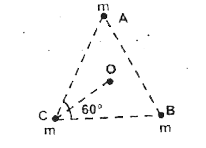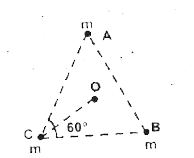The group of 100 to 1000 stars held in position by mutual gravitational forces are called
galactic clusters
globular clusters
comets
astetrods
(a)
Topper's Solved these Questions
Similar Questions
Three particles, each of mass m are fixed at the vertices of an equilateral triangle of side length a. The only forces acting on the particles are their mutual gravitational forces. Then answer the following questions.

The gravitational potential at O is
View SolutionThree particles, each of mass m are fixed at the vertices of an equilateral triangle of side length a. The only forces acting on the particles are their mutual gravitational forces. Then answer the following questions.

Force acting on particle C, due to particle A and B
View Solution
Knowledge Check
Gravitational force can be called as
Aforce without any fieldBforce at a distanceCcontact forceDfictitious forceA 10 kg satellite completes one revolution around the earth at a height of 100 km in 108 minutes. The work done by the gravitational force of earth will be –
A108×100×10JB(108xx10)/(100)JC0JD100×10108JConsider the two identical particles shown in the given figure. They are released from rest and may move towards each other influence of mutual gravitational force.
Gravitational potential energy of the two particle system
 Ais zeroBis contant (≠0)Cdecreases as the separation decreasesDincreases as the separation decreases
Ais zeroBis contant (≠0)Cdecreases as the separation decreasesDincreases as the separation decreases
A star of mass equal to two solar masses and radius 106km rotates about its axis with an angular speed of 10−6rads−1. What is the angular speed of the star, when it collapses (due to inward gravitational forces) to a radius of 104km?
View SolutionCan two particles be in equilibrium under the action of their mutual gravitational force? Can three particle be? Can one of the three particles be?
View SolutionThe force experienced by a unit mass at a point in the gravitational field is called its
View SolutionTwo particles of masses m and 3m are moving under their mutual gravitational force, around their centre of mass, in circular orbits. The separation between the masses is r. The gravitational attraction the two provides nessary centripetal force for circular motion
The ratio of centripetal forces acting on the two masses will be
View SolutionTwo particles of masses m and 3m are moving under their mutual gravitational force, around their centre of mass, in circular orbits. The separation between the masses is r. The gravitational attraction the two provides nessary centripetal force for circular motion
The ratio of the potential energy to total kinetic energy of the system is
View Solution
